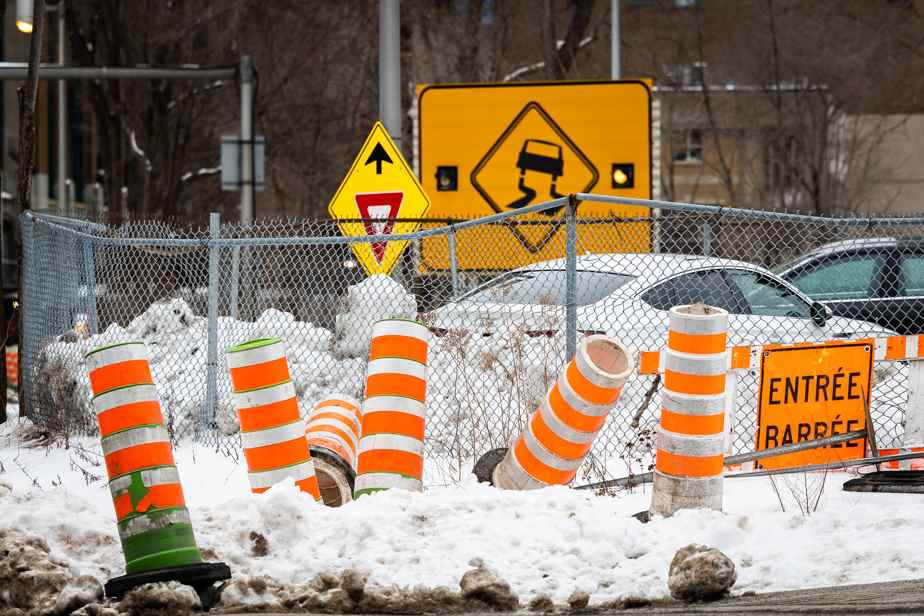The cones are everywhere, but we do not really know their number. The Ministry of Transport (MTQ) and the City of Montreal do not know so far how many orange cylinders are in the streets of the metropolis, the majority being private contractors hired to carry out the sites. For many, the situation illustrates that the authorities do not use all the technologies at their disposal.
The Board of Trade of Metropolitan Montreal (CCMM) recently unveiled a study highlighting the overabundance of traffic cones downtown. Despite the many data compiled by the authors, one question remained unanswered: how many are there?
“Contractors can put the cones in place themselves or do business with a subcontractor, but in all cases, Montreal is not able to specify the number of cones rented”, replies the spokesperson for the Ville, Hugo Bourgouin, in an email sent to The Press.
In the Legault government, the story is relatively the same. “The Ministère des Transports (MTQ) does not know the total number used nor the cost of purchasing this equipment, which is the property of private contractors, or municipalities, and which is generally included in traffic management contracts. “, admits the spokesperson for the MTQ, Louis-André Bertrand.
The CCMM noted however that in one year, 94% of the arteries of the city center had been blocked at one time or another. The study also showed that a quarter of these cones would be “useless”, that is to say “abandoned” or “without purpose”.
For example, downtown, 57% of Peel Street is lined with cones, and there are orange signs on 100% of the route. Rue Saint-Urbain, barriers have been in place for nine years, the study shows.
It is that in Montreal, the “majority” of cones are set up by general contractors, who obtain a work contract from the City. “The number of cones used depends on the size and complexity of the work sites,” says Mr. Bourgouin, who recalls in passing that many other work providers participate in the awarding of contracts, including the MTQ, the Commission electrical services, the Société de transport de Montréal (STM), Hydro-Québec, Bell or Énergir.
A technology to modernize
For transport planning expert Pierre Barrieau, the situation illustrates above all that site monitoring technologies are deficient in Quebec. “In the United States, in some cities, each signage item must have a barcode or an RFID device, which allows data to be collected remotely. It allows citizens to know, in real time: who owns this cone, how long it will be there, and what it is for, ”he explains.
It also allows city inspectors to quickly tell if equipment has the right to be on public roads, and thus remove the famous cones or signs lying around for nothing. When the cone is not declared, it is removed, and the contractor is fined. It’s that simple.
Pierre Barrieau, transportation planning expert
Such practices are “simple to implement”, argues the specialist, even if he recognizes that they would require adaptations in the industry.
“Certainly, there would be dissatisfied or concerned entrepreneurs, especially if they were asked to register their equipment on a web interface, for example, as is done elsewhere. But in itself, it is a measure that is not complex to implement,” says Mr. Barrieau, who estimates that such a measure would cost the City approximately $1 million.
A peak in sight
At the CCMM, President Michel Leblanc agrees. “There are solutions and in many cases they have been implemented elsewhere. And there, we must organize ourselves to make up for this delay. It goes through the identification of cones, through the accountability of the companies that operate the sites. We have to collectively decide to change things,” he says.

PHOTO MARTIN TREMBLAY, PRESS ARCHIVES
Michel Leblanc, President of the Board of Trade of Metropolitan Montreal
For him, the Summit on the City’s construction sites, which is to be held in the spring, will be a golden opportunity. “I expect the City to come up with a lot of solutions already, and that this is an opportunity to encourage support for those solutions. All the signals we’re getting from the industry are positive: companies are ready to review their ways of doing things, but the technology still has to be ready,” insists Mr. Leblanc.
The mayor of Montreal, Valérie Plante, rightly says that she aspires to “be able to change the culture of the orange cone in an urban environment”. “For the moment, it is the MTQ that governs the size and the distance between the cones. They are engineers, that’s how it works. But whether it’s Highway 40, 132 or right in the middle of downtown, for them, it’s the same thing, ”she illustrates in an interview.
In his view, the Worksite Summit will be an opportunity to see things differently. “In many other cities, there are smaller cones, different ways of developing the territory,” concedes the mayor. “Montreal is a city that needs to be renovated […], but it is true that it can be painful. The cones can in some cases contribute to making the city less attractive,” she concludes.
Learn more
-
- $59,000
- Every year, Montreal buys approximately 3,000 to 4,000 cones. “Over the past 12 months, just under $59,000 worth of cones have been consumed while the annual average is around $60,000. For this same type of cone, the City does not rent anything,” explains the spokesperson for the City of Montreal, Hugo Bourgouin.
source: City of Montreal
- 4000
- The MTQ owns more than 4,000 cones. “These cones are used everywhere in Quebec for the work carried out by the teams of the Ministry. Their location and number in use vary constantly according to current needs throughout the network in Quebec. There are no figures available for each region,” said MTQ spokesperson Louis-André Bertrand.
source: Quebec Ministry of Transport
